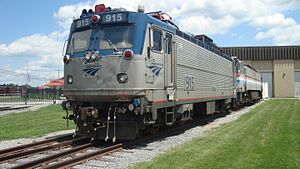AEM-7

AEM-7 #915 on display at the Railroad Museum of Pennsylvania
|
|||||||||||||||||||||||||||||||||||||||||||||||||||
|
|||||||||||||||||||||||||||||||||||||||||||||||||||
|
|||||||||||||||||||||||||||||||||||||||||||||||||||
|
|||||||||||||||||||||||||||||||||||||||||||||||||||
|
|||||||||||||||||||||||||||||||||||||||||||||||||||
| Type and origin | |
|---|---|
| Power type | Electric |
| Builder | General Motors Electro-Motive Division |
| Build date | 1978–1988 |
| Total produced | 65 |
| Rebuilder | Alstom Transport |
| Rebuild date | 1999-2002 |
| Number rebuilt | 29 |
| Specifications | |
|---|---|
| AAR wheel arr. | B-B |
| UIC class | Bo'Bo' |
| Gauge | 4 ft 8 1⁄2 in (1,435 mm) standard gauge |
| Wheel diameter | 51 1⁄8 in (1,299 mm) |
| Minimum curve | 245 ft (75 m) / 23.4° (single unit) 265 ft (81 m) / 21.6° (coupled) |
| Wheelbase | 25 ft 7 1⁄16 in (7.80 m) (between truck centers) |
| Length | 51 ft 1 25⁄32 in (15.590 m) (over coupler faces) |
| Width | 10 ft 5 9⁄16 in (3.189 m) (over handrails) |
| Height | 14 ft 8 1⁄2 in (4.483 m) (pan locked down) 25 ft 6 1⁄2 in (7.785 m) (pan fully extended) |
| Axle load | 51,225 lb (23,235 kg) |
| Adhesive weight | 100% |
| Loco weight | 204,900 lb (92,941 kg) max |
| Sandbox cap | 10.6 cubic feet (300 L) |
| Power supply | Catenary |
| Electric system(s) | |
| Current collection | Dual pantographs |
| Traction motors | ASEA LJH 108-5 (DC) Alstom 6 FXA 5856 (AC) |
| Head end power | 500 kilowatts (670 horsepower) (DC) 1,000 kilowatts (1,300 horsepower) (AC) |
| Transmission | 85:36 |
| MU working | yes |
| Train heating | Locomotive-supplied head-end power |
| Loco brake | Dynamic / Regenerative / Electropneumatic |
| Train brakes | Electropneumatic |
| Safety systems | ACSES II |
| Performance figures | |
|---|---|
| Maximum speed | 135 mph (217 km/h) (design) 125 mph (201 km/h) (operational) |
| Power output | AEM-7DC and AC: 5,100 kilowatts (6,800 horsepower) maximum at rail 4,320 kilowatts (5,790 horsepower) continuous at rail |
| Tractive effort | Starting Tractive Effort: 53,924 lbf (239.9 kN) (DC) 51,700 lbf (230.0 kN) to 43 mph (69 km/h) (AC) Continuous Tractive Effort: 30,000 lbf (133.4 kN) @ 77 mph (124 km/h) (DC) 39,500 lbf (175.7 kN) @ 65 mph (105 km/h) (AC) |
| Factor of adh. | ~ 3.85 |
| Loco brakeforce | 15,600 lbf (69.4 kN) (DC) 20,000 lbf (89.0 kN) (AC) |
| Career | |
|---|---|
| Numbers | |
| Nicknames | Toasters; Meatballs |
| Locale | Northeast Corridor, Keystone Corridor |
| Preserved | Amtrak #915 |
The AEM-7 is a twin-cab B-B electric locomotive that was used in the United States on the Northeast Corridor between Washington DC and Boston and the Keystone Corridor between Philadelphia and Harrisburg in Pennsylvania. They were built by Electro-Motive Division from 1978 to 1988. EMD manufactured 65 locomotives between 1978–1988; the majority of these were for Amtrak, other operators included MARC and SEPTA. Amtrak has retired their fleet in favor of the newer Siemens ACS-64, which entered service in 2014; MARC and SEPTA plan to replace theirs between 2017–2019.
Amtrak had inherited high-speed operations on the Northeast Corridor from the bankrupt Penn Central in 1971. Electrified passenger services between New York and Washington were handled by the new if unreliable Budd Metroliner electric multiple units and the aging PRR GG1s, originally built for the Pennsylvania Railroad in 1934–1943. Amtrak's first attempt at replacing the GG1 was the General Electric E60, delivered in 1974. The E60s proved unable to safely exceed 100 miles per hour (160 km/h) and Amtrak relegated them to hauling slower long-distance services. Amtrak turned to existing European high-speed designs, and two were brought over for trials in 1976–77: the Swedish Rc4 (numbered X995), and the French CC 21000 (X996). Amtrak favored the Swedish design, which became the basis for the AEM-7.
...
Wikipedia
